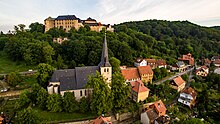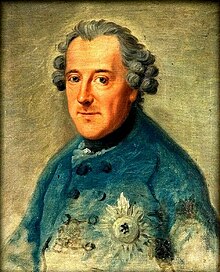Blankenburg Castle (Harz)
| Blankenburg Castle | ||
|---|---|---|
|
Blankenburg Castle seen from the old town |
||
| Creation time : | around 1123 | |
| Castle type : | Hilltop castle | |
| Conservation status: | Preserved, converted into a castle | |
| Standing position : | Noble | |
| Place: | Blankenburg (Harz) | |
| Geographical location | 51 ° 47 '10.6 " N , 10 ° 57' 16.2" E | |
| Height: | 305 m above sea level NN | |
|
|
||
The Great Blankenburg Castle is a building in the town of Blankenburg in the Harz district ( Saxony-Anhalt ). It was essentially built in the Baroque period on the basis of older buildings.
location
It is at 305 m above sea level. NN high Kalkberg Blankenstein built. The small castle with its baroque garden, tea house and museum, the city wall, the pheasant garden, the castle park and the castle pond are nearby . These form the palace gardens in Blankenburg (Harz) .
history
middle Ages
1123 attacked Lothar von Süpplingenburg von der Blankenburg on the Heimburg. The feudal sovereignty later fell to the Guelphs through Heinrich the Proud , father of Henry the Lion .
In 1128 Poppo received the county as a fief from the Frankish noble family of the Reginbodonen . His sons shared the county: Konrad received Regenstein Castle , Siegfried I the Blankenburg. Siegfried I never returned from a pilgrimage with Henry the Lion. He left two sons, Heinrich and Siegfried II.
In 1181, under the direction of Bishop Dietrich von Halberstadt, the siege of the castle and Blankenburg by imperial armies began. Emperor Friedrich Barbarossa took over the government.
In 1182 Blankenburg was conquered and finally released for plunder. The brothers Heinrich and Siegfried II went into captivity, but got the county back after the peace was restored. The new construction and a generous expansion of the castle began.
Count Heinrich took over the "settled" goods of the Regensteiners in 1190 and Siegfried II kept the county of Blankenburg , whose descendants kept Blankenburg in their possession until 1343. After that, the Blankenburg and Regenstein Castle fell back to the younger Heimburg line of the Regenstein family.
According to legend, in 1386 the Blankenburg was secretly plundered by Dietrich von Wernigerode during the night while Count Busso was absent. A head in the castle wall is evidence of this attack.
Renaissance
Around 1500 Count Ulrich XI. Despite large debts, forced to lay down the east wing and build a new building similar to a castle. In 1539 Count Ulrich V broke away from the Catholic Church.
On November 19, 1546, before moving into the new building, a fire broke out during the night, which destroyed large parts of the old castle. According to legend, the fire was kindled by the heater of the castle under the stairs of the old castle with dry brushwood after it had been paid for with gold by Baptists . The sleeping residents noticed the fire late. The maids and servants fled down the walls via the roofs and windows, but forgot their masters. The younger children, wrapped in towels, were let out of the windows by the guards. The pregnant Countess Magdalena von Regenstein was trapped in the flames. The countess asked her husband, Count Ulrich , to leave her in order to save his life. The count escaped through the toilet window and hung down from the outside. Below the half-burned count was saved. In memory of the fire and the dead, Count Ulrich had a plaque made in Latin and German. It shows the count, the countess, the six sons and four daughters.
In 1599 the Regenstein dynasty died out and the castle was returned to the Dukes of Braunschweig .
Baroque and modern times
In 1705 the renovation of the Renaissance castle into a baroque residence began by the master builder Hermann Korb on behalf of Duke Ludwig Rudolf von Braunschweig-Wolfenbüttel . The alterations envisaged a simpler and clearer structure of the outer form and lasted until 1731. Representative rooms (gray hall, speeches hall, imperial hall) inside and a court church as a multi-storey octagon were created.
In connection with the marriage of Elisabeth Christine under Ludwig Rudolf's residence with the later Emperor Karl VI. was elevated to the status of the principality by Emperor Joseph I. Blankenburg . Elisabeth Christine became the mother of the future Empress Maria Theresa .
The family of Duke Ernst August von Braunschweig and his wife, Duchess Victoria Luise Princess of Prussia, lived in the castle from 1930 until the flight and expropriation in 1945, which was granted to the family as private property in the course of the compensation for the princes in 1924. In 1917 the only daughter of the ducal couple, Friederike , who later became Queen of the Hellenes and mother of the Spanish Queen Sophia , was born here. In 1938 her wedding ceremony took place here on the occasion of her marriage to Prince Paul of Greece, who later became king. The Blankenburg court became famous for its splendid festivals and theater performances.
In 1945 the castle was declared public property and was used as a convalescent home by the social security from 1947 to 1957. From 1957 the college for domestic trade was housed in the castle. During this use, the building was structurally maintained. After the school closed with the end of the GDR in 1991, a long period of inactivity began, which led to the building being neglected. Plans by a buyer who bought the castle in 1996 to make it the center of a major tourism project were not implemented. Years of decay followed, resulting in leaky roofs, permanent moisture penetration of the building and infestation with dry rot and led to the risk of collapse. Vandalism and theft caused further decline.
In 2004, the first security work was carried out on the castle, which dragged on through 2005. At the same time, the preparations for the renovation began, which then began in December 2006. The castle chapel in the church wing of the castle and the porter's lodge belonged to the first renovation phase. In 2008 the castle was foreclosed and the new owner was Großes Schloss Blankenburg GmbH , which is a subsidiary of the Rettung Schloss Blankenburg eV association. While renovation work was still taking place in the theater wing, the theater hall was used again for the first time on May 28, 2011 after almost 20 years of vacancy. A branch office of the registry office of the city of Blankenburg was set up in the gray hall of the castle at the beginning of 2012 , the first wedding ceremony took place in May of the same year. On November 15, 2013, the tower clock was put back into operation and the partial renovation of the kitchen wing was officially completed.
architecture
It is a three-story plastered building complex that is arranged around an inner courtyard. The building includes a castle chapel with a high cross vault and several representative halls.
inventory
The inventory of the castle until 1945 included the only portrait or half-length portrait of the Prussian King Friedrich II from his reign, by the painter Johann Georg Ziesenis .
use
Essentially, Blankenburg Castle serves tourist and cultural purposes. Blankenburg Castle has been renovated in sections since 2005 and parts of it can be visited. The most representative rooms such as the gray hall decorated with stucco, the theater with gilded capitals, the palace chapel with high cross vaults, the imperial hall with stucco work by the sculptor Giacomo Perinetti and wall paintings and the knight's hall with illusionistic wall paintings from the 19th century and the palace courtyard are already accessible . The castle is open for events such as the Open Monument Day or the Historical Weekend.
There are exhibitions, readings and concerts in the castle. Wedding parties also come. Overall, "the castle is used actively".
Blankenburg Castle is also a filming location for film projects, including the following in 2017: Murder in the haunted castle of the ARD - crime series Alles Klara .
Rescue Castle Blankenburg e. V.
The aim of the association is to secure and maintain the Blankenburg Castle as an individual monument, an important cultural asset with supraregional and national importance and as a landmark of the city of Blankenburg with central historical importance. The aim of the association is achieved, among other things, by creating and mobilizing a broad public for the preservation and renovation of the palace in accordance with the historic monuments.
The association was founded in 2005 and exclusively and directly pursues charitable purposes. Chairman of the Association Rescue Schloss Blankenburg e. V. (VRSB) is Gerd Biegel .
In 2008 the Großes Schloss Blankenburg GmbH , a foundation of the association, bought the castle. According to plans by the planning ring Wernigerode, the repair of roofs, rain gutters and downpipes and the treatment of dry rot was started. The latter has now been achieved almost entirely. The maintenance and restoration work is also financed by government grants, which have to be applied for again and again. In 2010 the Federal Republic of Germany approved almost 3 million euros. Overall, the financing has not yet been secured. One problem is the return claims of the heirs of the previous owner, represented by Ernst August von Hannover (son of Ernst August von Hannover ), which apply to the movable inventory. According to the Compensation and Compensation Act, the movable inventory is to be returned to them while the property is owned by the association. In the case of wall paintings that were removed for restoration, the previous owner's representative raised claims for surrender, arguing that when they were removed from the wall, they were movable inventory.
The city of Blankenburg honored all members of the association for their great commitment to saving the Blankenburg landmark on October 29, 2010 with the Adolf Just Prize , which is donated annually by the Luvos Healing Earth Society . The association received the award on behalf of the members. On October 27, 2014, the association received the German Prize for Monument Protection , in the form of a silver hemisphere, for its long-term and voluntary commitment to the continuous preservation, renovation and use of the Great Blankenburg Castle as an outstanding cultural monument of supraregional importance and landmark of the city of Blankenburg .
literature
- Hans Adolf Schultz : Castles and Palaces of the Braunschweiger Land , Braunschweig 1980, Das Schloß Blankenburg , pp. 92–95, ISBN 3-87884-012-8
Web links
- Homepage of the association "Rescue Blankenburg Castle"
- Information page - The Great Castle on blankenburg.de
- View of the castle and town around 1880 on Kulturerbe.niedersachsen.de
- Video of a 360 ° flight around the castle on Youtube
Individual evidence
- ↑ a b c d e Blankenburg Castle - Past , accessed on August 19, 2019
- ↑ Blankenburg Castle - Endangered. on: welt.de July 8, 2003.
- ↑ a b c d e f g h Frankfurter Allgemeine Zeitung. December 31, 2013, p. 34.
- ↑ a b Blankenburg Castle - Present , accessed on August 19, 2019
- ^ Rescue of Blankenburg Castle e. V.







